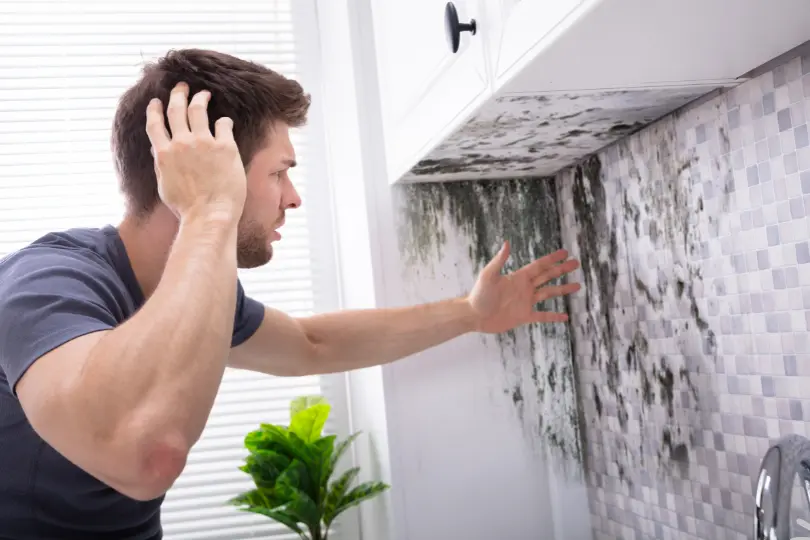
Mold exposure is a serious health concern that can cause various symptoms and long-term health issues. Mold thrives in damp, humid environments and can easily grow in homes, often unnoticed until it becomes a significant problem.
Mold spores are a known allergen and may cause various health problems when inhaled. It is critical to act swiftly and effectively to safeguard your health and reduce the issue if you suspect mold exposure.
7 Important Steps to Do if You Suspect Mold Exposure
This guide outlines 7 essential steps to take when dealing with potential mold exposure to ensure a safe and healthy living environment.
1. Identifying the Signs of Mold Exposure
Recognizing the symptoms of mold exposure is the first step in addressing the issue. Common symptoms include persistent coughing, sneezing, nasal congestion, and throat irritation. Individuals can also experience skin rashes, itchy eyes, and breathing difficulties, especially those with pre-existing respiratory conditions like asthma.
In some cases, mold exposure can lead to more severe reactions such as chronic fatigue, headaches, and even cognitive issues like memory loss. Identifying these signs early on can help you promptly address mold in your living environment.
2. Conducting a Thorough Home Inspection
A thorough house examination is required as soon as you notice any signs of mold exposure. First things first, check for mold. Mold may show up as white, green, or black spots on surfaces like walls and ceilings. Ensure that you provide extra care to damp places, including kitchens, basements, bathrooms, and spaces around windows.
In addition to visual inspection, use your sense of smell to detect any musty odors, which are a strong indicator of mold presence. If you are unable to locate the mold yourself, consider hiring a professional mold inspector who can use specialized equipment to identify hidden mold.
3. Testing for Mold Presence
Testing for mold presence is a crucial step if you suspect mold exposure in your home or workplace. Professional mold testing can accurately assess the extent of mold growth and identify the types of mold present. By engaging certified experts in testing, you can ensure thorough and reliable results that inform appropriate remediation efforts.
Testing involves collecting samples from various surfaces and air in the indoor environment, which are then analyzed in a laboratory for mold spores and other indicators of mold contamination. Understanding the findings from testing enables you to take prompt and targeted actions to address mold issues and protect your health and property.
4. Implementing Effective Mold Remediation
Once mold presence is confirmed, implementing effective remediation strategies is crucial to eliminate mold and prevent its recurrence. Small areas of mold can often be cleaned using household products like bleach or vinegar, but larger infestations typically require professional remediation.
Professionals use specialized equipment and techniques to remove mold and repair any damage to affected areas safely. It is also important to address the underlying cause of mold growth, such as leaks or inadequate ventilation, to prevent future outbreaks.
Ensuring thorough and effective remediation protects your health and restores a safe living environment.
5. Improving Home Ventilation
Improving home ventilation is a key strategy in preventing mold growth and ensuring a healthy indoor environment. Proper ventilation helps reduce moisture levels, which are essential for mold to thrive.
Use exhaust fans in bathrooms and kitchens to vent moisture outside, and ensure that your home has adequate airflow by opening windows and using fans when necessary.
Installing a dehumidifier can also help maintain optimal humidity levels, especially in damp areas like basements. Regularly inspecting and maintaining your HVAC system ensures it is effectively controlling indoor humidity and preventing mold growth.
6. Regular Monitoring and Maintenance
Ongoing monitoring and maintenance are essential to prevent mold recurrence and protect your health. Regularly inspect areas prone to moisture for signs of mold growth and promptly address any water leaks or dampness issues.
Keep your home clean and dry, paying special attention to areas like bathrooms and kitchens where mold is more likely to develop. Use mold-resistant products, such as paints and drywall, in areas susceptible to moisture.
Establishing a routine of regular checks and maintenance helps ensure that your living environment remains mold-free and healthy.
7. Consulting Healthcare Professionals
If you suspect mold exposure has affected your health, consulting healthcare professionals is crucial. Symptoms of mold exposure can mimic other health conditions, making it important to get an accurate diagnosis.
Inform your doctor about your concerns and any potential mold exposure, as they can conduct specific tests and evaluations. In some cases, a referral to a specialist, such as an allergist or pulmonologist, can be necessary for comprehensive care.
Early intervention and appropriate medical treatment can help mitigate the health impacts of mold exposure and improve your overall well-being.
Conclusion:
Addressing mold exposure promptly and effectively is essential for maintaining a healthy living environment. Recognizing the signs of mold exposure, conducting thorough inspections, and confirming mold presence through testing are critical initial steps.
Implementing effective remediation, improving home ventilation, and maintaining regular monitoring and maintenance are key strategies to prevent mold recurrence.
Consulting with healthcare professionals ensures that any health issues related to mold exposure are appropriately managed. By taking these proactive steps, you can protect your health and ensure a safe, mold-free home for you and your family.
About The Author:
Stacey Smith is a freelance health writer. She is passionate about writing about women’s health, dental health, diabetes, endocrinology, and nutrition and provides in-depth features on the latest in health news for medical clinics and health magazines.




